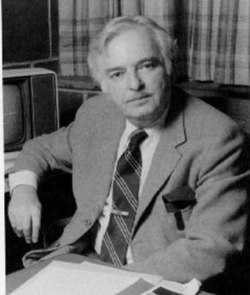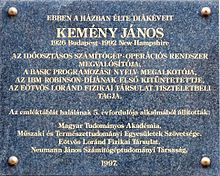Džon Džordž Kemeni — разлика између измена
. |
(нема разлике)
|
Верзија на датум 19. јун 2020. у 08:11
| Džon Džordž Kemeni | |
|---|---|
 Džon Džordž Kemeni | |
| Ime po rođenju | John George Kemeny |
| Datum rođenja | 31 maj, 1926 |
| Mesto rođenja | Budimpešta Mađarska |
| Datum smrti | 26. decembar 1992. (66 god.) |
| Mesto smrti | Hanover, Nju Hempšir Sjedinjene Države |
| Prebivalište | SAD |
| Državljanstvo | mađarsko |
| Obrazovanje | Univerzitet Prinston |
| Zanimanje | Predsednik Dartmut koledža |
Džon Džordž Kemeni (rođen kao Kemény János György; 31. maj 1926[1] – 36. decembar 1992) bio je američki matematičar mađarskog porekla, informatičar, i prosvetni radnik, koji je najpoznatiji po razvoju[2] programskog jezika Bejsik 1964. godine sa Tomasom Kuncom. Kemeni je služio kao 13. predsednik Dartmut koledža| od 1970 do 1981 i bio je pionir u oblasti upotrebe računara u univerzitetskom obrazovanju. Kemeni je predsedavao predsedničkom komisijom koja je istraživala Incident na ostrvu Tri milje 1979. godine.[2] Prema Đerđu Marksu on je bio jedan od Marsovaca.[3]
Rani život
Jedan korisnik upravo radi na ovom članku. Molimo ostale korisnike da mu dopuste da završi sa radom. Ako imate komentare i pitanja u vezi sa člankom, koristite stranicu za razgovor.
Hvala na strpljenju. Kada radovi budu završeni, ovaj šablon će biti uklonjen. Napomene
|
Rođen u Budimpešti u Mađarskoj u jevrejskoj porodici,[1] Kemeny attended the Rácz private primary school in Budapest and was a classmate of Nándor Balázs. In 1938 his father left for the United States alone. In 1940, he took the whole Kemeny family to the United States[1] when the adoption of the second anti-Jewish law in Hungary became imminent.[4] His grandfather, however, refused to leave and perished in the Holocaust, along with an aunt and uncle.[5] Kemeny's family settled in New York City where he attended George Washington High School. He graduated with the best results in his class three years later.[2] In 1943,[1] Kemeny entered Princeton University where he studied mathematics and philosophy, but he took a year off during his studies to work on the Manhattan Project at Los Alamos National Laboratory, where his boss was Richard Feynman. He also worked there with John von Neumann. Returning to Princeton, Kemeny graduated with an A.B. in mathematics in 1946 after completing a senior thesis, titled "Equivalent logical systems", under the supervision of Alonzo Church.[6] He then remained at Princeton to pursue graduate studies and received a Ph.D. in mathematics in 1949 after completing a doctoral dissertation, titled "Type-theory vs. set-theory", also under the supervision of Alonzo Church.[7][2] He worked as Albert Einstein's mathematical assistant during graduate school.[1]
Karijera
Kemeny was appointed to the Dartmouth Mathematics Department as a full professor in 1953, at the age of 27.[1] Two years later he became chairman of the Department, and held this post until 1967. Kemeny ventured into curriculum development when he introduced Finite mathematics courses. He teamed with Gerald L. Thompson and J. Laurie Snell to write Introduction to Finite Mathematics (1957) for students of biology and social sciences. The Dartmouth mathematics department professors also wrote Finite Mathematical Structures (1959) and Finite Mathematics with Business Applications (1962). Other colleges and universities followed this lead and several more textbooks in Finite Mathematics were composed elsewhere. The topic of Markov chains was particularly popular so Kemeny teamed with J. Laurie Snell to publish Finite Markov Chains (1960) to provide an introductory college textbook. Considering the advances using potential theory obtained by G. A. Hunt, they wrote Denumerable Markov Chains in 1966.[8] This textbook, suitable for advanced seminars,[9] was followed by a second edition in 1976 when an additional chapter on random fields by David Griffeath was included.
Kemeny and Kurtz were pioneers in the use of computers for ordinary people. After early experiments with the LGP-30, they invented the BASIC programming language in 1964, as well as one of the world's first time-sharing systems, the Dartmouth Time-Sharing System (DTSS). In 1974, the American Federation of Information Processing Societies gave an award to Kemeny and Kurtz at the National Computer Conference for their work on BASIC and time-sharing.[10] BASIC was the language used in most software written during the rise of the Apple II, the Commodore, the TRS-80, and the IBM PCs throughout the 80s.
Smrt

Džon Kemeni je umro u svojoj 66. godini, usled zatajanje srca u Lebanon u Nju Hempširu[2] dana 26. decembra 1992.[4] On je živeo u Etni, u blizini Dartmut kampusa.
Reference
- ^ а б в г д ђ Weibel, Peter (2005). Beyond Art - A Third Culture : a Comparative Study in Cultures, Art, and Science in 20th Century Austria and Hungary. Springer. стр. 350. ISBN 3-211-24562-6.
- ^ а б в г д Faison, Seth (1992-12-27). „John Kemeny, 66, Computer Pioneer and Educator (obituary)”. The New York Times. Приступљено 2008-02-02.
- ^ A marslakók legendája - György Marx
- ^ а б Ohles, Frederik; Shirley M. Ohles; John G. Ramsay (1997). Biographical Dictionary of Modern American Educators
 . Greenwood Publishing Group. стр. 189. ISBN 0-313-29133-0.
. Greenwood Publishing Group. стр. 189. ISBN 0-313-29133-0.
- ^ „True Basic. A sketch of John Kemeny” (PDF). Dartmouth Alumni Magazine. 2001-12-13. Приступљено 2012-07-23.
- ^ Kemeny, John G. (1946). Equivalent logical systems (на језику: енглески). Princeton, NJ: Department of Mathematics.
- ^ Kemeny, John George (1949). Type-theory vs. set-theory (на језику: енглески).
- ^ J. L. Doob (1966) Review: Denumerable Markov Chains, id 0207042
- ^ Preface, page vi
- ^ „TRANSCRIPTS OF 1974 National Computer Conference Pioneer Day Session”. Dartmouth Time Sharing System. Dartmouth College.
Spoljašnje veze
- The Papers of John G. Kemeny in the Dartmouth College Library
- Posted in the article with permission from Dartmouth College
- Dartmouth Wheelock Succession
- Bio at Bellevue C.C. site
- A sketch of John Kemeny for the Dartmouth Alumni Magazine
- O'Connor, John J.; Robertson, Edmund F. „Džon Džordž Kemeni”. MacTutor History of Mathematics archive. University of St Andrews.
- Džon Džordž Kemeni на сајту MGP (језик: енглески)
- Interview with Kemeny about his experience at Princeton
- True Basic Inc. information
